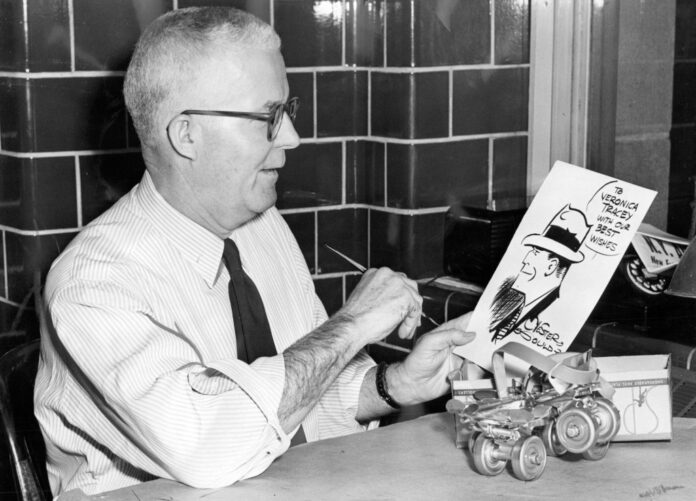There were many amazing things that one could see by joining the estimated 1 million people who came to the lakefront over the weekend for that annual festival of noise called the Chicago Air and Water Show.
“Best water on the planet,” shouted a guy selling plastic bottles of water for $5.
You could see, of course, airborne antics, parachutists, a biplane. The Blue Angels. Two men playing chess. There was a man with a colorful parrot on his shoulder and a woman whose face was painted red, white and blue. And near Oak Street, I saw an older man in a chair reading comics.
These days it’s a rarity, seeing a person reading a newspaper the old-fashioned way, which is ink on paper and not on a phone or laptop. But comics?
The man, who told me he lived in Kenosha, said he had been reading comics since he was a kid, “and that was a long time ago.” There was a newspaper on the ground at his side and the comics were in his hands. We talked for a while and then his two grandkids ran over and the Saturday sky show started.
“Have a look,” he said, handing me the comics.
Now, I have never been a regular reader of comics, not even as a kid, but I respect those who do (one grandmother was a rabid fan) and know they have been popular entertainments for more than a century.
Some people see them as firmly part of the country’s cultural fabric. Richard Marschall, the author of “America’s Great Comic-Strip Artists,” told me years ago. “The comic strip and jazz are the only two American art forms.”
Though many newspapers, the Tribune included, were running some pages of Sunday drawings and comics in the late 19th century, they were not in color and had no continuing characters.
The first newspaper comic strip character was featured in Joseph Pulitzer’s New York World in 1895. He was “The Yellow Kid,” a gap-toothed, jug-eared urchin dressed in a nightshirt. He became an instant sensation.
William Randolph Hearst, publisher of the rival New York Journal, hired the artist behind “The Yellow Kid” and made the comic the star of a Sunday package touted later in 1896 as “Eight Pages of Polychromous Effulgence That Make the Rainbow Look Like a Lead Pipe!”
The newspaper world recognized a circulation builder. After World War I, as comics were becoming daily staples in an increasing number of papers, the Chicago Tribune’s bosses, cousins Col. Robert R. McCormick and Capt. Joseph Medill Patterson, started to cultivate their own comics.
Patterson led the way, especially after moving to New York to start the Illustrated Daily News (soon to become the New York Daily News) in 1919.
“It is probably true that no other publisher in history — not even Hearst — took as much interest in the comics he published as Patterson did,” wrote Stephen Becker in his 1959 book, “Comic Art in America.”
Patterson helped create and nourish, among many other strips, “The Gumps,” “Gasoline Alley,” “Moon Mullins” and “Terry and the Pirates.” He was enthusiastically hands-on, offering advice, advising artists and coming up with promotional ideas. He often gathered cartoonists to discuss characters and storylines.
My favorite comic story concerns the day an artist came into Patterson’s office with a proposal for a strip called “Little Orphan Otto.” Patterson looked at the drawings. “He looks like a pansy,” he said, using derogatory language common at the time. “Put a skirt on the kid and call him Annie.”

Here’s another notable Tribune comic story.
When a man named Chester Gould arrived in Chicago in 1921, he found it “exhilarating” and decided to stay. He attended Northwestern University where he studied business and commerce. He married, started a family. He took classes at the Art Institute.
And he created comic strips for the city’s newspapers. He tried the Tribune but for a decade was unsuccessful. Then he came calling with drawings of a detective he called “Plainclothes Tracy.” Patterson had a look, shortened that to “Dick Tracy” and the strip was launched on Oct. 4, 1931.
It was an immediate hit. Gould and his family settled onto a farm in Woodstock and he commuted six days a week to Tribune Tower and, rarely taking a vacation, created in both places for half a century a vast array of strange characters and compelling plots and technological gizmos that fascinated the readers.
I was more than surprised to find Dick Tracy in the pages that Campbell had given me, “Doonesbury” too. I did not recognize such other strips as “Wumo,” “Frazz,” “Bound & Gagged,” or “Sherman’s Lagoon,” but assume they are popular with some people.
The pages also told me there was a place to “check out more than 75 other strips.” Seventy-five! Among them I found an offering called “Breaking Cat News” by Georgia Dunn. Ever seen it?
Originally Published:



